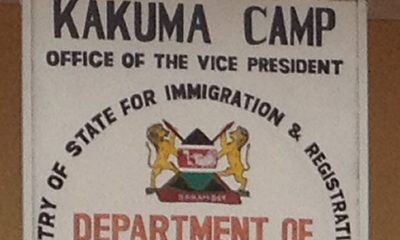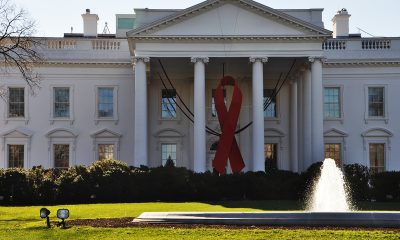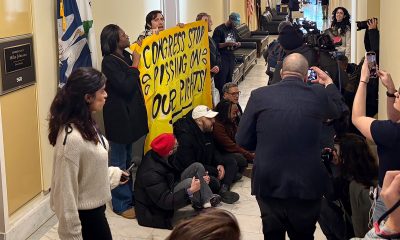Opinions
UNHCR must address suffering of LGBTI refugees in Kenya
Broader community remains largely indifferent to camp abuses
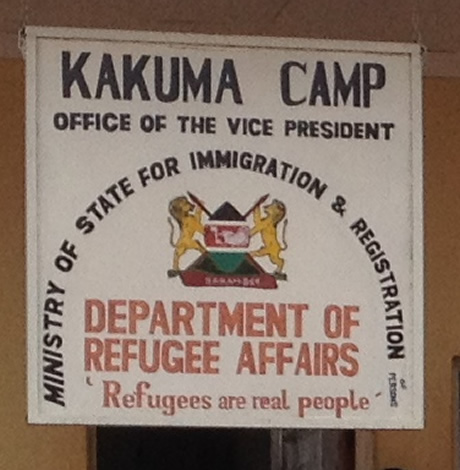
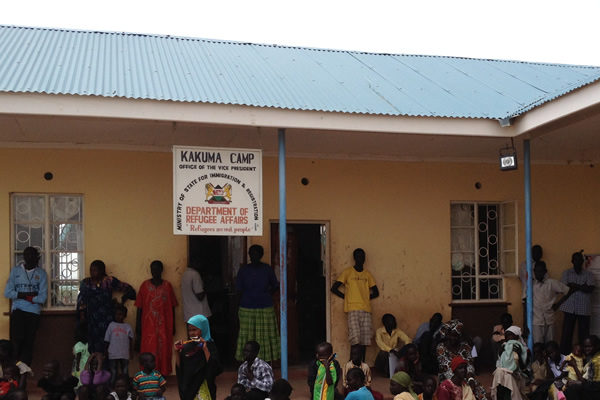
LGBTI activists in the U.S., Belgium, the Netherlands, Germany, the U.K. and other countries are expressing a growing concern about the way in which a considerable group of African LGBTI refugees, or at least part of them, are being treated in Kenya. Whereas they appreciate the efforts of UNHCR (the U.N. Refugee Agency), they also deplore the continuous cries of despair coming out of Kenya, especially from LGBTI refugees in Kakuma Refugee Camp. We urge UNHCR to take these claims and problems more seriously and to open a serious dialogue with the aim of improving the situation considerably. This needs to happen in the short term.
Homosexuality is criminalized in all but a few countries in Africa, which means that LGBTI people live marginalized and often in terror of their lives. Even in the countries that do accept sexual diversity, such as South Africa, which goes as far as to recognize same-sex marriage, the power of disapproval by society is such that LGBTI people live in fear of exposure, loss of jobs, or rejection by their families to the extent of being killed in “honor killings.” Many LGBTI citizens in Africa are being excluded from their families or communities, which explains why many of them flee to other countries hoping to find a decent life there.
The situation has received evermore media attention over the past decade, fomented by the Ugandan government’s particularly hostile stance, which provoked an exodus by LGBTI people, one which is ongoing. The obvious destination for these persons of concern, asylum seekers and refugees is neighboring Kenya, where UNHCR is based in Nairobi. For some years, the resettlement of LGBTI refugees in third countries proceeded at a reasonable pace, but the refusal of the Kenyan government last year to decriminalize homosexuality, plus the obdurate stance of the U.S. administration not to accept more refugees from certain categories, has worsened the situation. We also see that other countries, for example those of the European Union, don’t do enough to accept LGBTI refugees from Kenya, where at least many hundreds of them have fled.
The Kenyan government insists that LGBTI refugees be kept in refugee camps, the largest and most notorious of these being Kakuma in Turkana County in the north of Kenya. There, some two hundred LGBTI refugees from Uganda, Burundi, Rwanda, the Democratic Republic of Congo, Ethiopia, Somalia and South Sudan, women, children and men, are kept without any protection, subject to attack by others living at the camp, mostly Sudanese, and the local Turkana people. Police protection is not provided, since Kenya insists that LGBTI people there are not refugees but “criminals.” A mercenary security company G4S is also complicit in the brutality towards LGBTI refugees. The medical facilities at Kakuma frequently refuse to treat LGBTI refugees.
Advocates from around the world have been lobbying UNHCR to act and remove these LGBTI refugees to a safe place, but these appeals fall on deaf ears. The stance of UNHCR is that the stories by LGBTI refugees of attacks are either fabricated or greatly exaggerated, but eyewitness accounts by the LGBTI refugees themselves provide evidence in videos, photographs and graphic emails. The attacks are extremely violent, involving knife and panga attacks and burning of living quarters, theft of food and mobile phones, and refusal of access to shops and water.
Trust in UNHCR is fast eroding, as no one can understand what the agency’s agenda is; it mostly maintains a deafening silence. The suspicion is that it is under the thumb of the Kenyan authorities, and does not have the moral stamina to confront Kenya on this abuse of human rights. One thing is certain: UNHCR, under High Commissioner Filippo Grandi, does not welcome outsiders’ emails, and other than bland assurances that all is well at the camp, or protestations (amounting to threats) that emails on behalf of individuals put them at further risk, there is no comment from Geneva, Nairobi or the Kakuma Refugee Camp itself. Social media access has been blocked, and the belief among LGBTI people is that this is on the direct orders of UNHCR, in collusion with the Kenyan authorities. Some clearly don’t like the LGBTI refugees to inform the international community about what they are undergoing!
While Black Lives Matter has taken the world by storm, Black LGBTI Lives in Africa do not get a look in, and the LGBTI world outside shows virtually no interest, preferring to concentrate on celebrating Pride month as though the battle has been fought and won. It never will be, but the very least that can be done is to remove all LGBTI refugees from Kakuma, as happened in December 2018, before the Kenyan authorities stepped in and ordered their return to Kakuma, with the evermore gory results that are being seen, harrowing videos and photographs of bodies hacked and bloodied, with minimal medical care and attention.
We would love serious NGOs like Amnesty International, Human Rights Watch and others to step in and get involved. To our satisfaction, we notice a growing willingness within the NGO community to get involved and investigate the claims and worries of many LGBTI refugees in Kenya. The world cannot continue to look away. And we, as serious LGBTI activists, clearly refuse to look away and leave these fellow human beings to their (sad) fate.
Commentary
Elusive safety: what new global data reveals about gender, violence, and erasure
Movements against gender equality, lack of human rights data contributing factors.
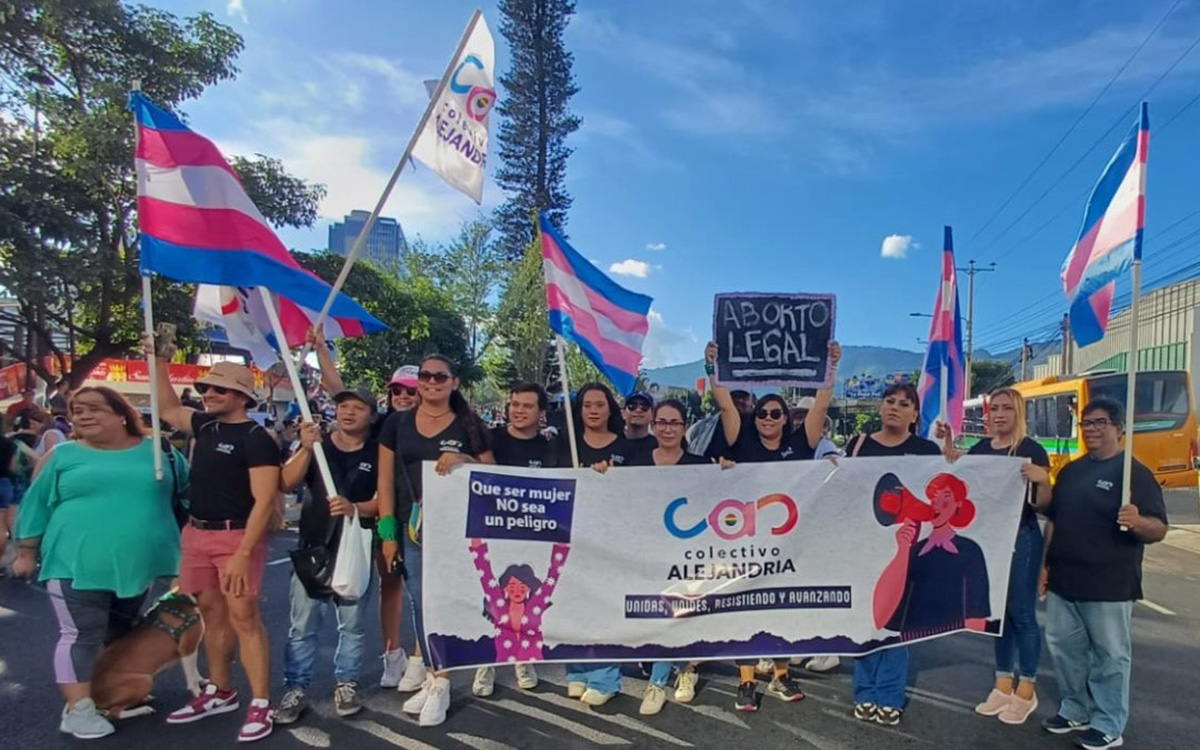
“My identity could be revealed, people can say whatever they want [online] without consequences. [Hormone replacement therapy] is illegal here so I’m just waiting to find a way to get out of here.”
-Anonymous respondent to the 2024 F&M Global Barometers LGBTQI+ Perception Index from Iraq, self-identified as a transgender woman and lesbian
As the campaign for 16 Days Against Gender-Based Violence begins, it is a reminder that gender-based violence (GBV) — both on– and offline — not only impacts women and girls but everyone who has been harmed or abused because of their gender or perceived gender. New research from the Franklin & Marshall (F&M) Global Barometers and its report A Growing Backlash: Quantifying the Experiences of LGBTQI+ People, 2022-2024 starkly show trends of declining safety among LGBTQI+ persons around the world.
This erosion of safety is accelerated by movements against gender equality and the disappearance of credible human rights data and reporting. The fight against GBV means understanding all people’s lived realities, including those of LGBTQI+ people, alongside the rights we continue to fight for.
We partnered together while at USAID and Franklin & Marshall College to expand the research and evidence base to better understand GBV against LGBTQI+ persons through the F&M Global Barometers. The collection of barometers tracks the legal rights and lived experiences of LGBTQI+ persons from 204 countries and territories from 2011 to the present. With more than a decade of data, it allows us to see how rights have progressed and receded as well as the gaps between legal protections and lived experiences of discrimination and violence.
This year’s data reveals alarming trends that highlight how fear and violence are, at its root, gendered phenomena that affect anyone who transgresses traditional gender norms.
LGBTQI+ people feel less safe
Nearly two-thirds of countries experienced a decline in their score on the F&M Global Barometers LGBTQI+ Perception Index (GBPI) from 2022-2024. This represents a five percent drop in global safety scores in just two years. With almost 70 percent of countries receiving an “F” grade on the GBPI, this suggests a global crisis in actual human rights protections for LGBTQI+ people.
Backsliding on LGBTQI+ human rights is happening everywhere, even in politically stable, established democracies with human rights protections for LGBTQI+ people. Countries in Western Europe and the Americas experienced the greatest negative GBPI score changes globally, 74 and 67 percent, respectively. Transgender people globally reported the highest likelihood of violence, while trans women and intersex people reported the highest levels of feeling very unsafe or unsafe simply because of who they are.
Taboo of gender equality
Before this current administration dismantled USAID, I helped create an LGBTQI+ inclusive whole-of-government strategy to prevent and respond to GBV that highlighted the unique forms of GBV against LGBTQI+ persons. This included so-called ‘corrective’ rape related to actual or perceived sexual orientation, gender identity, or expression” and so-called ‘conversion’ therapy practices that seek to change or suppress a person’s gender identity or expression, sexual orientation, or sex characteristics. These efforts helped connect the dots in understanding that LGBTQI+ violence is rooted in the same systems of inequality and power imbalances as the broader spectrum of GBV against women and girls.
Losing data and accountability
Data that helps better understand GBV against LGBTQI+ persons is also disappearing. Again, the dismantling of USAID meant a treasure trove of research and reports on LGBTQI+ rights have been lost. Earlier this year, the US Department of State removed LGBTQI+ reporting from its annual Human Rights Reports. These played a critical role in providing credible sources for civil society, researchers, and policymakers to track abuses and advocate for change.
If violence isn’t documented, it’s easier for governments to deny it even exists and harder for us to hold governments accountable. Yet when systems of accountability work, governments and civil society can utilize data in international forums like the UN Universal Periodic Review, the Convention on the Elimination of All Forms of Discrimination Against Women, and the Sustainable Development Goals to assess progress and compliance and call for governments to improve protections.
All may not be lost if other countries and donors fill the void by supporting independent data collection and reporting efforts like the F&M Global Barometers and other academic and civil society monitoring. Such efforts are essential to the fight against GBV: The data helps show that the path toward safety, equality, and justice is within our reach if we’re unafraid of truth and visibility of those most marginalized and impacted.
Jay Gilliam (he/him/his) was the Senior LGBTQI+ Coordinator at USAID and is a member of the Global Outreach Advisory Council of the F&M Global Barometers.
Susan Dicklitch-Nelson (she/her/hers) is the founder of the F&M Global Barometers and Professor of Government at Franklin & Marshall College.
Commentary
Second ‘lavender scare’ is harming our veterans. We know how to fix it
Out in National Security has built Trans Veterans State and Local Policy Toolkit

Seventy years after the first “lavender scare” drove LGBTQ Americans from public service, a second version is taking shape. Executive directives and administrative reviews have targeted transgender servicemembers and veterans, producing a new wave of quiet separations and lost benefits.
The policy language is technical, but the result is personal. Veterans who served honorably now face disrupted healthcare, delayed credentials, or housing barriers that no act of Congress ever required. Once again, Americans who met every standard of service are being told that their identity disqualifies them from stability.
Out in National Security built the Trans Veterans State and Local Policy Toolkit to change that. The toolkit gives state and local governments a practical path to repair harm through three measurable actions.
First, continuity of care. States can keep veterans covered by adopting presumptive Medicaid eligibility, aligning timelines with VA enrollment, and training providers in evidence-based gender-affirming care following the World Professional Association for Transgender Health Standards of Care Version 8.
Second, employment, and licensing. Governors and boards can recognize Department of Defense credentials, expedite licensing under existing reciprocity compacts, and ensure nondiscrimination in state veterans’ employment statutes.
Third, housing stability. States can designate transgender-veteran housing liaisons, expand voucher access, and enforce fair-housing protections that already exist in law.
Each step can be taken administratively within 90 days and requires no new federal legislation. The goal is straightforward: small, state-level reforms that yield rapid, measurable improvement in veterans’ daily lives.
The toolkit was introduced during a Veterans Week event hosted by the Center for American Progress, where federal and state leaders joined Out in National Security to highlight the first wave of state agencies adopting its recommendations. The discussion underscored how targeted, administrative reforms can strengthen veterans’ healthcare, employment, and housing outcomes without new legislation. Full materials and implementation resources are now available at outinnationalsecurity.org/public-policy/toolkit, developed in partnership with Minority Veterans of America, the Modern Military Association of America, SPARTA Pride, and the Human Rights Campaign.
These are technical fixes, but they carry moral weight. They reaffirm a basic democratic promise: service earns respect, not suspicion.
As a policy professional who has worked with veterans across the country, I see this moment as a test of civic integrity. The measure of a democracy is not only who it allows to serve but how it treats them afterward.
The second “lavender scare” will end when institutions at every level decide that inclusion is an obligation, not an exception. The toolkit offers a way to begin.
For more information or to access the toolkit once it is public, visit outinnationalsecurity.org/toolkit.
Lucas F. Schleusener is the CEO of Out in National Security.

For years, the far right has relied on a familiar infrastructure to wage its political battles: coordinated legal networks, back-channeled money, and an ever-growing pipeline of model legislation that moves quietly from one statehouse to another. What used to be a fringe ecosystem of activist lawyers has matured into something far more muscular. Today, the attacks on LGBTQ Americans—especially transgender people—are not random. They are designed, drafted, and deployed by a disciplined constellation of groups that understand how to move legislation with precision. And if Democrats, civil rights advocates, and national LGBTQ organizations continue treating each bill as an isolated outrage rather than a unified offensive, this machine will keep outpacing them.
Most Americans have never heard of outfits like the Alliance Defending Freedom, the American Principles Project, the Leadership Institute’s law arm, or the network of state-based policy shops that orbit the Heritage Foundation. But these entities now function as the shadow authors of state legislation. The anti-trans sports bans that appeared in more than 20 states did not arise organically; they were cloned from drafts circulated by ADF attorneys. The same is true for bills restricting gender-affirming care, limiting name and pronoun accommodations in schools, or expanding “religious liberty” carve-outs that allow discrimination against LGBTQ employees or customers. Legislators often change a few words, swap in a local sponsor, and reintroduce the same provisions session after session — giving the impression of momentum when, in reality, only a handful of ideologues are writing the nation’s culture-war script.
The operational model is simple: produce a bill, partner with a state-level think tank, recruit a legislator to introduce it, and provide legal testimony to defend it. But the strategic sophistication lies upstream. These groups have spent years cultivating relationships with attorneys general, state solicitors, and conservative judges who are sympathetic to their worldview. They draft legislation with litigation in mind, anticipating which language will survive scrutiny before the federal courts they have worked diligently to remake. They treat policy, politics, and jurisprudence as a seamless ecosystem; meanwhile, LGBTQ advocates are forced to fight on three fronts at once, often with smaller budgets and no comparable network of state-by-state affiliates.
What is most striking now is the acceleration. Bills that used to be test-driven in one or two states are being introduced in a dozen simultaneously. After the Supreme Court’s Dobbs decision, the same legal strategists pushing abortion bans pivoted almost immediately toward restricting trans health care, framing puberty blockers and hormone therapy as “sterilization.” The rhetorical shift was not accidental. It was a deliberate legal construction designed to open the door to future Fourteenth Amendment challenges, should the movement secure a case capable of reaching the Supreme Court. This is not simply a legislative fight; it is the groundwork for long-term judicial warfare.
And yet, Democrats and even national LGBTQ groups often treat these measures as if they were spontaneous outbursts of local prejudice. That is politically naïve. The reason similar bills appear in Idaho, Florida, Tennessee, Kansas, and Ohio at the same time is because they originate from the same set of PDFs stored on the same servers belonging to the same legal networks. The far right has embraced an industrial model of anti-LGBTQ policymaking: mass production, rapid deployment, and coordinated amplification by media channels that echo the same talking points across state lines.
The consequence is that the burden falls on queer people themselves—especially trans people—to respond to an avalanche of bills, hearings, lawsuits, and administrative changes that no individual or small advocacy team can fully track. When you have a network of attorneys feeding language to legislators, drafting amicus briefs, and preparing future litigation strategies in advance, you create an asymmetry that is difficult to counter with reactive press releases or one-off legal challenges. This imbalance of power is not about public opinion, which still supports LGBTQ equality by wide margins. It is about institutional positioning. The far right has placed its lawyers where the pressure points are: in state AG offices, in coordinated legislative caucuses, in judicial clerkships, and in the nonprofit legal trenches where issue fights are shaped long before the public hears about them.
There is a path forward, but it requires abandoning the old model of treating each bill as a separate emergency. LGBTQ organizations need a unified, long-range strategy that mirrors the discipline of the groups attacking them. That means state-by-state legal surveillance, rapid drafting of counter-model legislation, formal partnerships with progressive state AGs, and a standing litigation coalition capable of anticipating—not just responding to—legal threats. It also means investing in local leaders who understand that these bills are symptoms of a national machine, not quirks of their hometown politics.
What’s at stake here is nothing less than the architecture of civil rights in the United States. The far right is attempting to rewrite the legal landscape through volume and repetition, hoping courts will eventually treat these contrived bills as reflections of a shifting national consensus. They are betting that if they introduce enough legislation, in enough states, for enough years, the judiciary will reinterpret LGBTQ equality not as a settled constitutional principle but as a contested social question that can be narrowed or rolled back. Their ultimate goal is not just to restrict trans rights today but to lay the doctrinal groundwork for limiting LGBTQ protections for a generation.
The community can still win this fight, but only if it sees the battlefield clearly. These bills are not local skirmishes—they are coordinated acts of legal engineering. And it is time the pro-equality movement built an equally coordinated system to match them.
Isaac Amend is a writer based in the D.C. area. He is a transgender man and was featured in National Geographic’s ‘Gender Revolution’ documentary. He serves on the board of the LGBT Democrats of Virginia. Contact him on Instagram at @isaacamend
-

 The White House5 days ago
The White House5 days agoTrans workers take White House to court over bathroom policy
-

 Opinions5 days ago
Opinions5 days agoEverything is Everything
-

 Federal Government5 days ago
Federal Government5 days agoHHS ‘peer-reviewed’ report calls gender-affirming care for trans youth dangerous
-

 Congress4 days ago
Congress4 days agoMTG resigns after years of anti-LGBTQ attacks amid Trump feud

